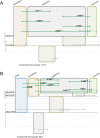Further resolution of the house mouse (Mus musculus) phylogeny by integration over isolation-with-migration histories
- PMID: 32933487
- PMCID: PMC7493149
- DOI: 10.1186/s12862-020-01666-9
Further resolution of the house mouse (Mus musculus) phylogeny by integration over isolation-with-migration histories
Abstract
Background: The three main subspecies of house mice, Mus musculus castaneus, Mus musculus domesticus, and Mus musculus musculus, are estimated to have diverged ~ 350-500KYA. Resolution of the details of their evolutionary history is complicated by their relatively recent divergence, ongoing gene flow among the subspecies, and complex demographic histories. Previous studies have been limited to some extent by the number of loci surveyed and/or by the scope of the method used. Here, we apply a method (IMa3) that provides an estimate of a population phylogeny while allowing for complex histories of gene exchange.
Results: Results strongly support a topology with M. m. domesticus as sister to M. m. castaneus and M. m. musculus. In addition, we find evidence of gene flow between all pairs of subspecies, but that gene flow is most restricted from M. m. musculus into M. m. domesticus. Estimates of other key parameters are dependent on assumptions regarding generation time and mutation rate in house mice. Nevertheless, our results support previous findings that the effective population size, Ne, of M. m. castaneus is larger than that of the other two subspecies, that the three subspecies began diverging ~ 130 - 420KYA, and that the time between divergence events was short.
Conclusions: Joint demographic and phylogenetic analyses of genomic data provide a clearer picture of the history of divergence in house mice.
Keywords: Divergence; IMa3; Population size; Speciation.
Conflict of interest statement
The authors declare no competing interests.
Figures


Similar articles
-
Higher differentiation among subspecies of the house mouse (Mus musculus) in genomic regions with low recombination.Mol Ecol. 2011 Nov;20(22):4722-36. doi: 10.1111/j.1365-294X.2011.05285.x. Epub 2011 Oct 18. Mol Ecol. 2011. PMID: 22004102 Free PMC article.
-
[Genetic differentiation of subspecies of the house mouse Mus musculus and their taxonomic relationships inferred from RAPD-PCR data].Genetika. 2008 Jun;44(6):841-9. Genetika. 2008. PMID: 18727395 Russian.
-
Phylogeography of Chinese house mice (Mus musculus musculus/castaneus): distribution, routes of colonization and geographic regions of hybridization.Mol Ecol. 2014 Sep;23(17):4387-405. doi: 10.1111/mec.12873. Epub 2014 Aug 21. Mol Ecol. 2014. PMID: 25065953
-
Tracing the eastward dispersal of the house mouse, Mus musculus.Genes Environ. 2015 Aug 1;37:20. doi: 10.1186/s41021-015-0013-9. eCollection 2015. Genes Environ. 2015. PMID: 27350815 Free PMC article. Review.
-
Wild-derived mice: from genetic diversity to variation in immune responses.Mamm Genome. 2018 Aug;29(7-8):577-584. doi: 10.1007/s00335-018-9766-3. Epub 2018 Jul 28. Mamm Genome. 2018. PMID: 30056578 Free PMC article. Review.
Cited by
-
Sex-specific variation in the genome-wide recombination rate.Genetics. 2021 Mar 3;217(1):1-11. doi: 10.1093/genetics/iyaa019. Genetics. 2021. PMID: 33683358 Free PMC article.
-
Population structure and inbreeding in wild house mice (Mus musculus) at different geographic scales.Heredity (Edinb). 2022 Sep;129(3):183-194. doi: 10.1038/s41437-022-00551-z. Epub 2022 Jun 28. Heredity (Edinb). 2022. PMID: 35764696 Free PMC article.
-
Bidirectional Introgression between Mus musculus domesticus and Mus spretus.Genome Biol Evol. 2022 Jan 4;14(1):evab288. doi: 10.1093/gbe/evab288. Genome Biol Evol. 2022. PMID: 35038727 Free PMC article.
-
Across two continents: The genomic basis of environmental adaptation in house mice (Mus musculus domesticus) from the Americas.PLoS Genet. 2024 Jul 5;20(7):e1011036. doi: 10.1371/journal.pgen.1011036. eCollection 2024 Jul. PLoS Genet. 2024. PMID: 38968323 Free PMC article.
-
Anapc5 and Anapc7 as genetic modifiers of KIF18A function in fertility and mitotic progression.bioRxiv [Preprint]. 2024 Dec 4:2024.12.03.626395. doi: 10.1101/2024.12.03.626395. bioRxiv. 2024. Update in: Sci Rep. 2025 Jul 2;15(1):23046. doi: 10.1038/s41598-025-08766-w. PMID: 39677807 Free PMC article. Updated. Preprint.
References
-
- Morse HC. The laboratory mouse—A historical perspective. In: Foster HL, Small JD, Fox JG, editors. The mouse in biomedical research. New York: Academic Press; 1981. pp. 1–16.
-
- Morse HC. Building a better mouse: One hundred years of genetics and biology. In: Fox JG, Barthold SW, Davisson MT, Newcomer CE, Quimby FW, Smith SL, editors. The mouse in biomedical research. 2. San Diego: Academic Press; 2007. pp. 1–11.
Publication types
MeSH terms
Associated data
Grants and funding
LinkOut - more resources
Full Text Sources

